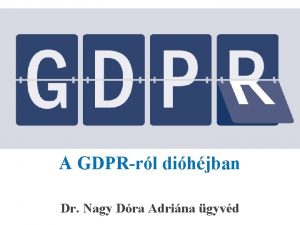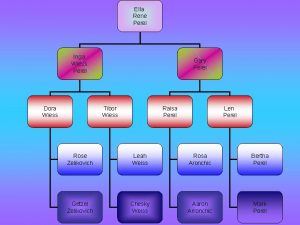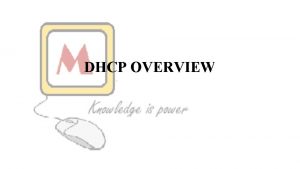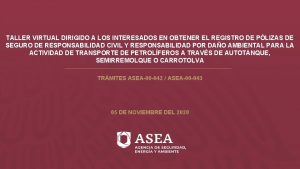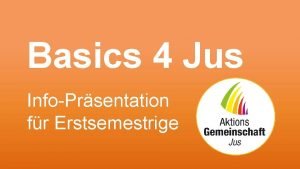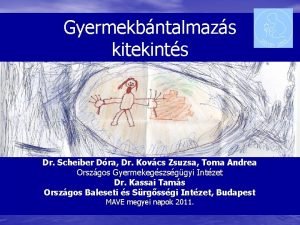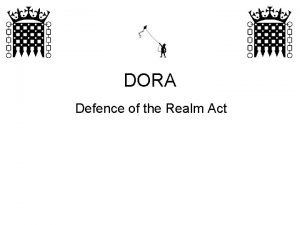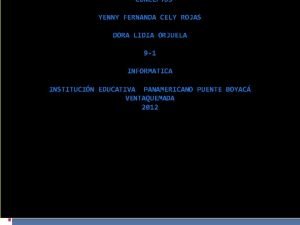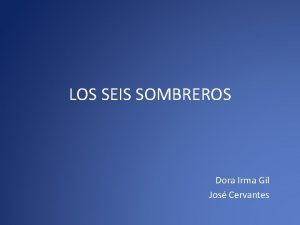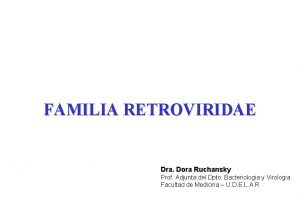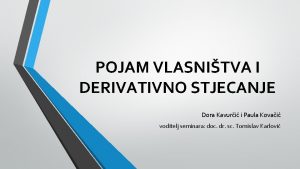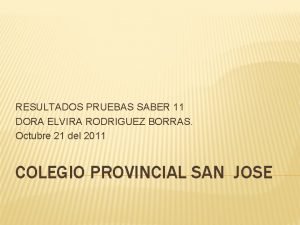DGH dghidvegigmail com or dora hidvegisap com n












































- Slides: 44

DGH dghidvegi@gmail. com or dora. hidvegi@sap. com n Master of Economics (1995) n n Budapest University of Economics Studies at University of Cologne n Quality Auditor (ISO 19011) n 2005 - present SAP Globalizaztion Services n n 1996 -2005 Oracle Hungary n n SM Project Lead for Tax@Business By. Design Principal consultant of Oracle Financials. Participated and managed numerous implementation projects and pre-sales activities. Consulting Quality Manager. Localization Manager of Hungary and the (then) new EU countries. 1992 -1996 Scala ECE n n n Responsible for business development in Croatia, Slovenia, Romania and Bulgaria, Accountant of Scala ECE and Scala Hungary Senior consultant and trainer of Scala Financials modules

Agenda 1) What is localization? - Coffee break 2) Special focus: EU regulations

What is localization? Being compliant with… …specific country requirements and …multiple country requirements in parallel in the area of: 1) Internationalization 2) Language support 3) Functional localization

1) Internationalization n Multi language support n Code pages n Unicode n Time zones n Multiple currencies, country codes, etc n Multiple and specific Calendars

2) Local Languages Local language on the UI ---) special case: Hebrew, Arabic, Chinese Local language for documents printed from the system ---) especially legal documents like Invoices, Tax declarations, etc. Local language for certain delivered/user entered content ---) like Name prefixes (Mr, Mrs, etc) choosable from value lists Local language for user documentation

3) Functional localization Compliance with local legal and business requirements n Local ----) n region/country/state/county/city/etc. n Legal requirements ----) n defined and documented by country officials n Business requirements ----) n common practice of businesses n Also for content pre-delivered with system ---) of increasing importance!

Global and Local elements Global n Calendar n Language handling n Time Zone support n Global Master Data n Chart of Accounts design n Global and integrated processes Local n Tax handling n Financial reporting n Local processes n Country specific configuration options (eg. : Chart of Accounts) n Country specific installation program for preconfigured settings/content n Etc…

Why localize? n A) With certain requirements a software MUST comply ---) Gapless customer invoice numbering and copy tracking. In HU the software must be certified by officials and software vendor must issue a certificate of compliance when selling the product n B) You can not get a customer if you don’t n C) you have contractual obligations? !? ---) watch out for the wording of contracts

Maintenance of localizations n continuous activity of n Monitoring and following up changes n Last minute changes of law --) short response time needed Localization of any new functionality of the software n Supporting users of localizations n n Legal requirements are usually high prio messages

What to localize? n What makes sense from a business perspective n Justifyable business case of selling the product/ functionality n The consequence of not localizing is great enough (eg. : fines) Be pragmatic, but keep in mind that localization becomes only visible when it is missing and that is potentially too late…

Organizational aspects Localization is ALL over… Usually defined as an independent function within the company Regularly moved among the major divisions (development, sales, support, consulting)

And who pays for it? n It is primarily a cost ---) development, sales, support, consulting, etc… n Indirectly it generates license revenue ---) product can be sold n Indirectly it generates consulting revenue ---) implementation of localizations, special knowledge n Increases customer satisfaction n Creates huge unsatisfaction if missing Hard to quantify revenue saved or generated by localization

and now… COFFEE TIME

Localization topics in EU n What is the product to be sold in a country of EU? n What are the requirements/legislations in general effecting the product? n What are the effeccting EU ones? n What are the effecting local country ones? ---) EU gives directives to the countries and each country must harmonize it’s own legislation meet EU requirements.

Country versus EU 1 st level: COUNTRY entities must comply with local regulations 2 nd level: EU country must comply with EU requirements Discrepancy: European Court of Justice rules (ECJ)

European Court of Justice (ECJ) Article 220 of EC States: The court of Justice shall ensure that in the interpratation and application of this Treaty the law is observed (EC= European Community based on the Treaty of Rome)

Primary Community Laws n Refers to the provisions of the original three Treaties: ECSC –European Coal and Steel Community (expired 23 July 2002) Euratom – European Atomic Energy Community EEC (later EC) – European Economic Community Later amended by: Single European Act (1 July 1987) Treaty on European Union (Treaty of Maastrich) Treaty of Amsterdam Treaty of Nice

Single European Act n Introduced a cooperation platform for the coordination of foreign policy under the name European Political Coopertion n Reformulated the objective of the common market as an internal market (an area without borders) and set the deadline 31 Dec 1992 to relaize this n ---) the European Tax law underwent dramatic changes at this time

Treaty on European Union n Treaty of Maastricht, Dec 1992 n The original three tresties underwent substantial changes, including change from EEC to EC n Established the European Union: The Union is not a searate legal personality, best seen as the organized totality of the relations between the Member States.

EU= The roof of a building Best described as a roof where the building has 3 pillars: A Community pillar, comprising the two treaties II. Common foreign and security policy (CFSP) III. Provisions on coopertion between the Member States in the field of justice and home affairs I.

Nice Declaration – the Treaty for Constitution of Europe Nice European Council, Dec 2000 Declaration on the future of the Union was adopted Institutional reforms launch a debate on the future of the EU Laeken European Council Convening of an IGC in 2004

European Constitution Key Elements: n There will be only one European Union, replacing „European Communities”, and the „European Union”, n the three pillars will be merged (special procedures will be replaced by „Treaty establishing a Constitution of Europe”) n The Charter for Fundamental Rights will be integrated into the text --) simplification n Entering force only when all MS ratified

Secondary Community Law n Decisions taken by the institutions entitled to take them under the three (now two) primary treaties via: Regulations n Directives (EU 6 th Directive on VAT) n Decisions n Recommendations n Opinions n

The Community Institutions n The European Parliament n The Council (NOT the European Council) n The Commission n The Court of Justice (ECJ) n The Court of Auditors

Ancillary bodies Supporting the 5 Institutions n The European Economic and Social Committee n The Committee of the Regions n The European Central Bank n The European Investment Bank n The European ombudsman

ECJ n Located in Luxembourg n Ensures that in the interpretation and application of the Treaty the law is observed n Direct appeals by individuals and companies n Disputes between Member States and Institutions n Between Institutions n One judge per Member State n 8 Advocates General

The Council n Lay down and implement legislation n Representatives of the governments of the Member States n Ensures the coordination of the general economicc policies of the MSs n Legislative authority n Responsible for concluding agreement between Community and non-member countries or international organizations n Responsible for common foreign and security policy

The Commission n Executive Committee of the EC n Exclusive right of initiative --) no proposal, no act by the Council n Supervisor: ensures the obervance by the Member States of their obligations under the Treaty n May institute proceedings against a MS that may lead to judgment by ECJ n Executes the tasks of the Commission

Important legal requirements n IFRS n 6 th directive on VAT n Direct taxation (profit tax, etc) n Statistical declarations: eg: Intrastat n Industry Specific regulations (eg: ECB for National Central Banks and commercial banks)

IFRS n International Financial Reporting Standards n Post Enron world n World-wide n Applied also by EU n In addition to local GAAP n Must be supported by softwares n Need to support multiple country specific GAAPs parallel n Localized Financial Statements

Direct Taxation n Double taxation treaties n Usually not supported directly by generic softwares, only special nieche ones

VAT n Very important for any software in the ERP world n Also for nieche software from which purchasing, sales or inventory management is performed n Complex and troublesome to implement: n Massive transactional data to be calculated and stored in proper detail n Legal reporting of VAT is high prio n Auditability of data and processes

VAT n EC Articels 23 -31: n free movement of goods, n customs union and n prohibition of quantitative restrictions n EC Articles 90 -93: n prohibit fiscal discrimination, n fiscal dumping with indirect taxes, n instructs the Council to adopt provisions for further harmonisation of indirect taxes

VAT n VAT Directive 2006/112 n National VAT Acts n ECJ Rulings

Characteristics of VAT n A general turnover tax: VAT covers all goods, services and imports, unless the law explicitly provides otherwise n An „all-stage” tax: VAT covers all persons engaged in economic activities in the chain of production and distribution of goods and services n A „non-cumulative” tax: taxable persons are entitled to deduct VAT on inputs n An”indirect tax”: VAT is not born by the taxable person who remits it to the government, but the final consumer

VAT - Neutrality principles n Legal neutrality: Tax burden is proportionate to final consumers expenditures n Economic neutrality: n No incentive to vertical aggregation of business activities n Neutral with respect to outsourcing activities n Neutral with respect to allocation of means of production n Internal neutrality: also own consumption is subject to tax n External neutrality: n exports are relieved from VAT in country of origin n Imports are taxed in country of destination

Subject to VAT n The supply of goods and services n Effected for consideration n Within the territory of the country n By a taxable person acting as such

Taxable Person - VAT n Any Person n Who independently carries out n in any place n Any economic activity n Whatever the purpose or results

Taxable transaction types - VAT n Domestic n Intra-Community Trade n Third Country

Intra-Community– Supply of goods n Only if a supply involves movement of goods can it be exempted n Dispatched or transported goods n n Po. S is where dispatch or transport of goods begins Po. S in MS (Member State) of import Goods installed or assembled: Po. S= where installation Chain transaction: § On who’s behalf are the goods transported § Where am I in the chain ---) am I before or after the transport responsible. . . ? n Goods NOT dispatched or transported Place where supply takes place n Supplies in EU on ships/trains/aircrafts n Point of departure (or first embarkation in EU) n Gas/Power via grid and pipeline n Po. S depends on the nature of buyer (where customer resides) n

Intra-Community– Supply of services n General Rule: Po. S where supplier has established his business or has a fixed establishment from which service is supplied n or has his permanent address or where he usually resides n Exceptions from general rule: n Intermediary Services – Po. S where underlying supply takes place n Services related to immovable property – Po. S where immovable property is located n Passenger Transport Services – where transport takes place, having regard to distances covered n Services related to certain activities – Po. S where services are carried out n Intangible/professional services – Po. S where customer is established if the customer is a taxable person established in an other MS or is not a taxable person resident outside EU n Special rules for simplification and tax avoidance prevention: n Margin Scheme: tour operators/travel agents, second hand goods, works of art, antiques n Special Scheme for investment gold n

Intrastat n Intrastat is the name given to the system for collecting statistics on the trade in goods between the countries of the European Union (EU). n It has been operating since 1 January 1993, and replaced customs declarations as the source of trade statistics within the EU. n The requirements of Intrastat are similar in all Member States of the EU.

Intrastat n Similar to VAT: n transactional data to be identified, stored and declared n Data of Intrastat is closely related to primary VAT data in the systems, often based on VAT data n Differences to VAT: n Intrastat is based on the movement of goods (Ship from and Ship to) n Not all VAT transactions are relevant for Intrastat

Thank You!
 Bài thơ mẹ đi làm từ sáng sớm
Bài thơ mẹ đi làm từ sáng sớm Cơm
Cơm Nagy dóra adriána
Nagy dóra adriána Dora perelli
Dora perelli Frane bitunjac
Frane bitunjac Apipa ip
Apipa ip Dora pejačević
Dora pejačević Interdictum de arboribus caedendis
Interdictum de arboribus caedendis Zlatni rez
Zlatni rez Dora mali
Dora mali Dora chico
Dora chico Dora ruiz
Dora ruiz Tikvicki dóra
Tikvicki dóra Dora la exploradora
Dora la exploradora Dora luz llanes herrera
Dora luz llanes herrera Vvz juridicum
Vvz juridicum 1924-1883
1924-1883 In dora
In dora Pere ubu dora maar
Pere ubu dora maar Scheiber dóra
Scheiber dóra Remembrance emily bronte
Remembrance emily bronte


